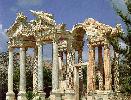| Aphrodisias... |
|
This city now being excavated by a Turkish professor, Kenan Tevfik Erim. The first excavations were carried out in 1905
by the French archaeologist, Paul Gaudin. The leader of the present excavations, Prof. Erim, is from New York University.
He has been excavating here since 1961. These excavations have revealed much mew material for the world of archaeology. It
is difficult to say when they will be completed, but every year millions of Turkish liras are spent on new excavations,
and 100-200 workers are employed on the site to reveal ever-new evidence of this magnificent city. However even today in
its present state, Aphrodisias is well worth a visit. One cannot hep but admire the various tones of the marble fragments
scattered over the site; statues, life-like and animated; amazing works of art in marble as smooth as silk. The spectacle
of white marble against tall green poplars provides timeless pleasure. The earliest settlement in Aphrodisias goes as far
back as the Bronze age. Various soundings on the slopes of the acropolis have revealed evidence that the city goes back to
a very early period: finds dating from the 3rd millennium BC have been unearthed. The city has had many names
during its history. For example, in its early stages, it was known as Nimova, because of which it was associated with
Mesopotamia. This important Carian city is encircled by walls 3.5 km. in length. The town occupies an area of 250 hectares.
The old part of the modern Turkish village of Geyre occupies some parts of the site. It is possible that Geyre is a modern
derivation of the no way inferior to any of the Greek schools, and in fact, many of the reliefs and statues found in Rome
and Greece bear the signatures of artists from Aphrodisias. During the Roman period, especially during the reign of Augustus
and Tiberius, Aphrodisias reached the apex of its wealth and fame. It had become by then a highly respected city, exempt
from taxes and enjoying religious privileges. The city produced many great works of sculpture, literature, and medicine.
To the north of the site is the stadium, which was capable of seating 30,000 spectators. This magnificent construction is
262 meters in length and although exposed to the elements ancient religious name of Caria. Aphrodisias had its own school
of art. During the reign of Attalus III of Pergamon, the king abandoned his kingdom to Rome, two artists of the time then
left Pergamon and migrated inland to settle in Aphrodisias.
|
|

|






